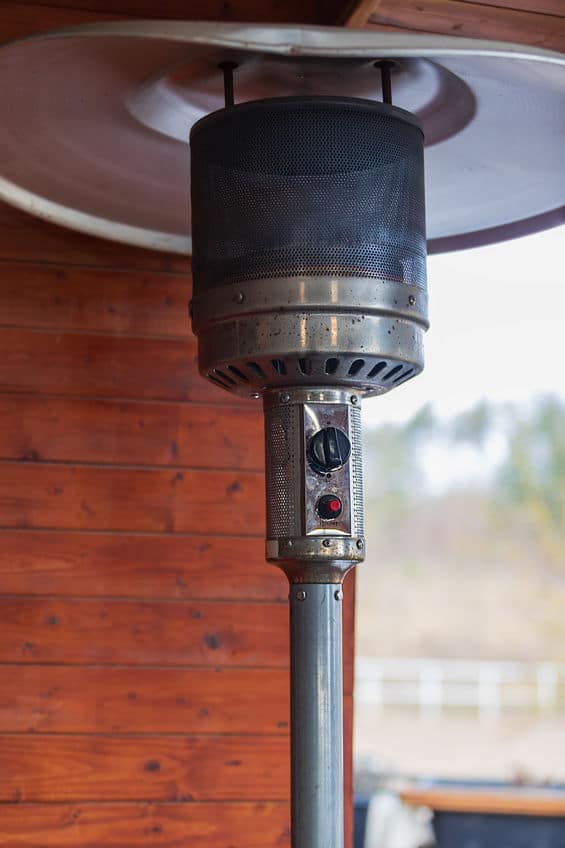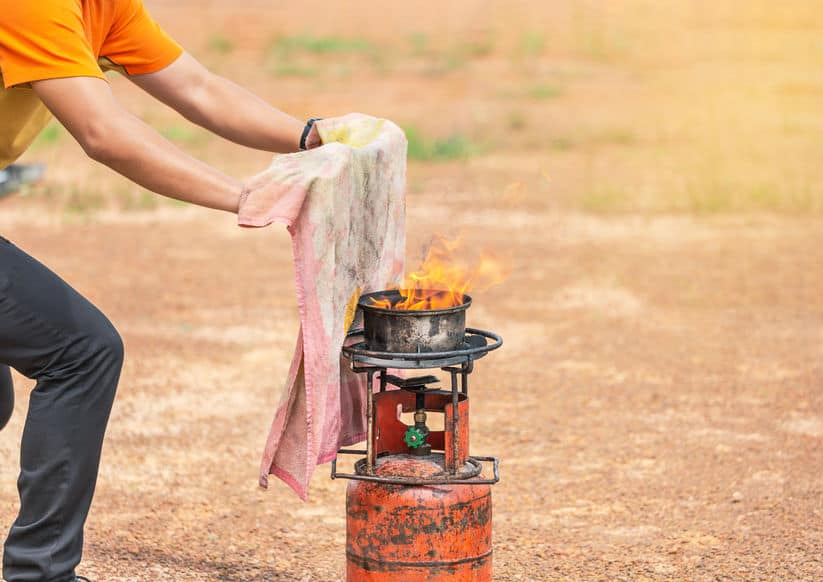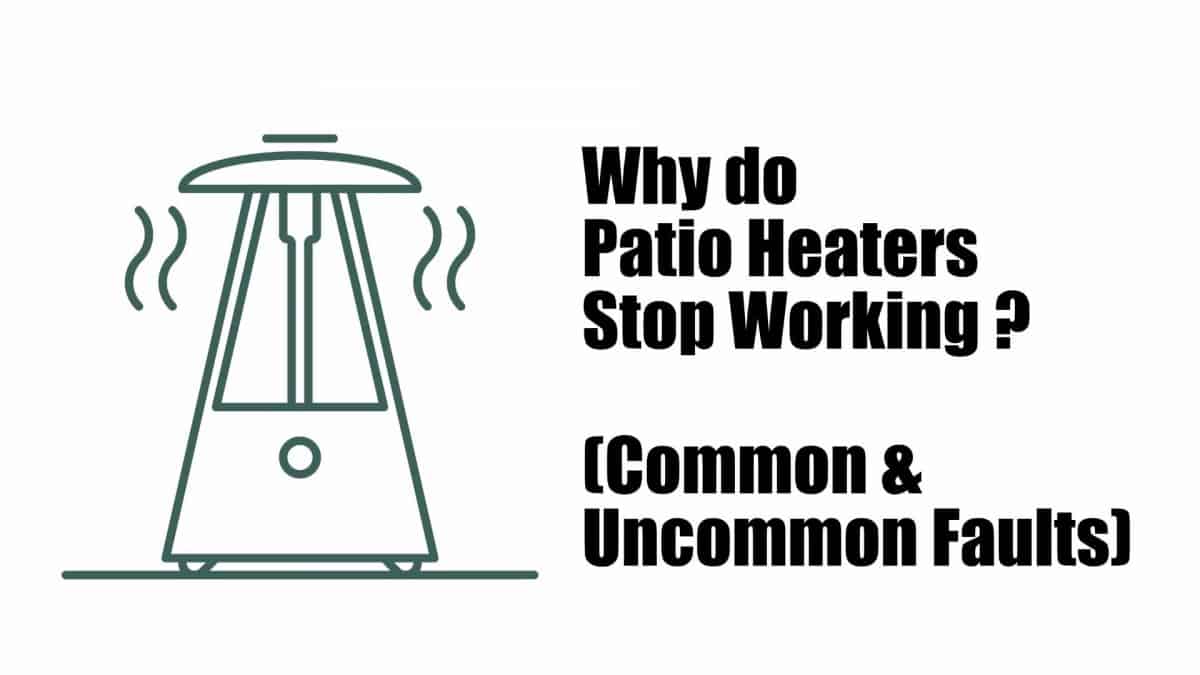As soon as the weather shifts towards winter, open-air gatherings take a backseat. But the change of weather should not stop us from enjoying the outdoors completely, and for that reason, patio heaters are a must-have appliance.
Having a party with friends and family on a chilly evening, with a patio heater warming up the ambience, is super comfortable.
In case, one evening the patio heater suddenly stops working or just doesn’t start, it could be frustrating and completely spoil the fun.
To avoid freezing during a gathering, it’s better to know how the patio heater works, why it can stop working, and what can be done to fix it as soon as possible.
Common Faults Summary
We’ll go into way more detail on these faults later in the article and suggest solutions for each one of them:
| No or Less Heating |
| Problematic Gas Cylinder |
| Worn out Igniter |
| Leakage in Gas Pipe |
| Switched off Regulator |
| Blocked Orifice |
| Loose Connections |
| Failure of Thermocouple |
| Frozen Regulator |
At the end of the article we’ll also discuss 10 uncommon faults as well.
How the Patio Heater Works
Patio Heaters burn natural gas, wood, or propane to radiate heat. Some heaters might use electricity, but the most common ones use propane.
The mechanism by which they work is radiant heating. Unlike forced-air heating where air particles are heated and warm air is blown out, filling the spaces between you and the heater, patio heaters warm objects by radiating heat to them.
There is a burner on top of the patio heater where the burning of propane or natural gas takes place.
The flames are directed against a perforated metal screen. The screen is shaped in a cylinder and heat radiates from it in a circular pattern around it.
On top of the cylinder, there is a silver screen which efficiently reflects heat lost upwards. Silver is bad at absorbing and great at reflecting, therefore it serves the purpose in the best way.
The latest patio heaters, which use electricity, warm the surroundings by emitting infrared heat to them.
What to do if the Patio Heater Stops Working?

Sometimes the patio heater can act up and stop working. Multiple ends can be checked to pinpoint the problem.
There can be certain faults in the setup, lack of maintenance, or other issues. We’re going to highlight some common and uncommon faults that contribute to the problems faced:
Common Faults
No or Less Heating
As these machines are simple and easy to use, the possible problems are in a few components.
If the heat generated is low, the first thing you should check is the gas supply and the burner. There could be a problem with the burner; it might have to be cleaned or replaced.
The gas supply could be an issue too. If a spark is seen when closing the heater, it means the gas supply is troubled.
You might even see a small gas cloud near the burner indicating problems with the burner.
To solve this issue, it’s important to call a professional and not meddle with it yourself, as a flammable substance can cause the situation to worsen.
Strong winds may blow out the lit pilot light, and to overcome this, the thermocouple and the pilot light should be moved closer using a pair of pliers.
Problematic Gas Cylinder
At times, the reason behind your heater not working may be as simple as an empty gas cylinder.
In that case, it needs to be disconnected and refilled. Sometimes the cylinder might have gas remaining, but it might not be enough to create the pressure required for the fire to ignite.
Getting the cylinder refilled is imperative in this situation too.
If you notice that the gas cylinder is finishing up faster than usual, despite normal usage, you should urgently get it checked by a technician and see if there are any leakages.
If there are, it’s of utmost priority to either replace the cylinder or sort the leakage out before you turn the heater on again. You don’t want any explosion accidents taking place!
Worn out Igniter
With time, the igniter gets worn out and just does not work. To check if the igniter is busted, you will have to test it manually. First and foremost, check if the pilot light is burning. If it is not, look for blockages in the gas pipe.
Next, remove the emitter, and take a stick lighter. Make sure to hold the control knob in the pilot position as you try to ignite it yourself. If that does not work either, you should heat the thermocouple for 30 seconds.
Then you should move the control knob to a low flame and try to ignite the main burner. If this is successful, turn the burner to full so that all the dust and debris is burnt and cleared, enabling it to work perfectly again.
If the problem persists, you have limited options. You should disconnect the gas pipe from the end of the unit and the top of the control unit as well.
Air should be blown into the pipe, while you push the control knob in its position. If there is still no spark, you just have to replace it.
Leakage in Gas Pipe
If the gas cylinder is filled and the heater still does not work, the pipelines need to be checked for leakages and blockages.
The solution for blockages is disconnecting the pipe from the cylinder and the burner and blowing air into the pipe. If there is a leakage, the pipe can be repaired or replaced.
Switched off Regulator
The function of the regulator is simple; it takes the gas to the burner.
Some regulators have switches inside them which sometimes meddle with the gas flow and prevent the valve present at the topmost portion of the cylinder to turn on.
If the regulator in your heater has this switch, you need to check if it is on and working properly.
Blocked Orifice
In the burner, there is a small chamber where gas and air mix. It’s important to check the inlets of air and gas to avoid that.
If your heater is not working up to its best potential, this chamber needs to be checked for optimal usage of the gas.
Loose Connections
Check all the fittings of the heater thoroughly, especially the regulator. Do the soap and water test to ensure that all connections are tight, with no leakages whatsoever.
Failure of Thermocouple
Patio heaters that come with pilot lights may have a failed thermocouple. The thermocouple is V-shaped and placed inside the pilot light’s flame.
Sometimes, the thermocouple gets coated with a thick layer of carbon from the burning of propane. The carbon should be gently scraped off the thermocouple.
If the thermocouple is broken, the pilot light goes off each time it is turned on. In this situation, the thermocouple should be replaced.
Frozen Regulator
Due to the occasional inflow and usage of propane, one difficult problem that occurs is the freezing of the regulator.
Liquid Propane enters and passes through the control device. During this, it is likely that the regulator freezes.
To avoid this problem, one should keep cylinders and tanks in designed spaces and spots.
It’s important to keep them at a certain location as instructed in the manual, so that downstream appliances such as the regulator, which works with liquid propane, do not freeze and flow fully to the burner.
As this entire problem is complicated, an expert needs to resolve it. If one does not understand where and how the cylinder should be placed, professional advice should be taken to understand why the regulator freezes and what steps can be taken to avoid it.
Some Uncommon Faults and Helpful Tips

- The burner pilot of your patio heater should be clear from all kinds of dirt and trash. It is possible that some junk accumulated in the area or some insect got stuck. You should regularly clean it, and keep it dry and free from debris.
- Check the reflector, igniter, and mesh around the pilot button for carbon build-up. If there is any carbon, scrape it off for optimum exposure to heat. The carbon build-up in the brass tube is what stops the gas from reaching the burner.
- The gas pipe might be kinked. Straighten it up and fix it.
- The regulator might not fit into the gas cylinder. This happens when you replace the regulator or the cylinder. It is important to see that the regulator you buy is compatible with your cylinder, otherwise, you will have to go and get it replaced.
- In winters, use Propane. Usage of Butane will not give you enough warmth and will leave you cold.
- Check if the regulator is in proper condition. If it is torn, it needs to be replaced urgently.
- If the gas cylinder being used is irreplaceable, it should be checked for leakages thoroughly. If there are leakages, the burner should not be turned on.
- If the flame is low, check for bugs and insects in the pilot assembly valve, venturi tube, and burner ports. If there are any, remove them.
- A gas cylinder that is ¼ filled will not light up the burner if the temperature is below 4⁰C. To resolve this, the cylinder needs to be refilled or replaced.
- Keep the heater somewhere stable, where it won’t topple over or be mishandled by children and pets. If it falls over or is struck by something, something might break or come loose inside it.
So, there you have it. Those were the most likely diagnoses to the problems your heater may be facing.
Knowing the faults that might occur in patio heaters helps you in identifying the degree of the problem, and these troubleshooting tips make fixing the heater super easy!
Alright guys, that’s it for this article, if you are interesting in reading more about patio heaters, we have lots of cool articles related such as:
Can Patio Heaters be Used on a Deck (Read This First!)
Can Patio Heaters be Used on a Screened-in Porch? (Quick Facts)

